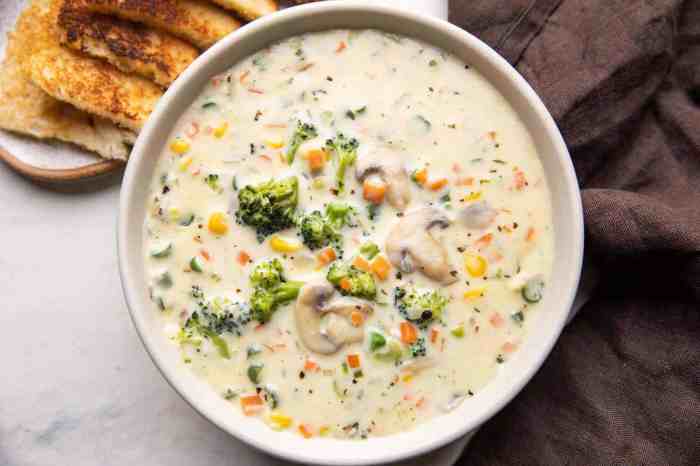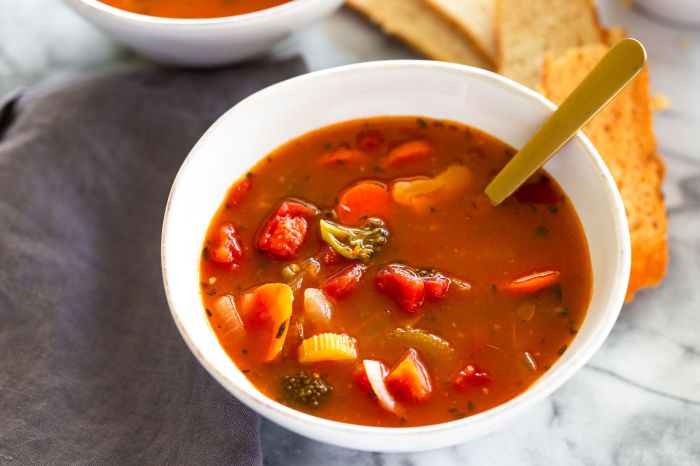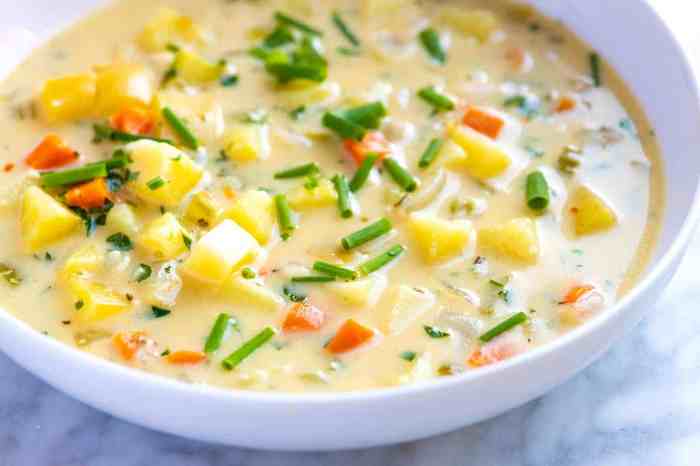Soup Recipe Variations
Recipe for soup – Soup recipes are incredibly versatile, allowing for endless creativity and adaptation to different tastes and dietary needs. Exploring various cuisines and cooking techniques unlocks a world of flavor profiles and textures.
Popular Soup Recipes from Around the World

Source: myfoodstory.com
The following table showcases examples of popular soups from various culinary traditions, highlighting their key ingredients and unique characteristics.
| Cuisine | Soup Name | Key Ingredients | Brief Description |
|---|---|---|---|
| Italian | Minestrone | Vegetables (beans, pasta, zucchini), broth | A hearty vegetable soup with pasta, known for its vibrant flavors and nutritious ingredients. |
| Asian | Tom Yum Soup | Lemongrass, galangal, chilies, shrimp or chicken, coconut milk | A spicy and sour Thai soup with fragrant herbs and a creamy coconut milk base. |
| French | French Onion Soup | Caramelized onions, beef broth, baguette, Gruyère cheese | A classic French soup featuring deeply caramelized onions and topped with melted cheese on toasted bread. |
| Mexican | Caldo de Pollo | Chicken, vegetables (onions, garlic, carrots), spices (cumin, oregano) | A comforting chicken soup with a flavorful broth and various vegetables, often seasoned with Mexican spices. |
| Indian | Dal Tadka | Lentils, spices (turmeric, cumin, coriander), ghee or oil | A lentil-based soup with a flavorful tempering of spices in clarified butter or oil. |
Tomato Soup Variations
Tomato soup offers a great canvas for experimentation. Here are three variations highlighting different approaches.
- Classic Simmered Tomato Soup: Fresh tomatoes simmered with onions, garlic, and herbs, then blended for a smooth texture. A simple yet flavorful option.
- Roasted Tomato Soup: Roasting tomatoes before simmering intensifies their sweetness and depth of flavor. This method results in a richer, more complex soup.
- Spicy Tomato Soup with Coconut Milk: Adding coconut milk and chilies to the classic recipe creates a creamy, spicy, and uniquely flavorful variation.
A Unique Soup Recipe: Roasted Butternut Squash and Apple Soup with Sage
This recipe combines the sweetness of butternut squash and apple with the earthy notes of sage, creating a surprisingly harmonious flavor profile.
- Roast cubed butternut squash and apples with olive oil, salt, and pepper at 400°F (200°C) for 30 minutes.
- Sauté chopped onion and garlic in a pot until softened.
- Add the roasted squash and apples to the pot, along with vegetable broth and fresh sage leaves.
- Simmer for 15 minutes, then blend until smooth.
- Season with salt and pepper to taste. A drizzle of maple syrup can enhance the sweetness.
Soup Recipe Ingredients
Understanding the role of different ingredients is key to crafting delicious and flavorful soups. The choice of broth, vegetables, herbs, and spices significantly impacts the final product.
The Role of Broth
Different broths impart distinct flavor profiles to soups. Vegetable broth provides a light and savory base, chicken broth adds richness and umami, while beef broth offers a bolder, more intense flavor.
Common Soup Vegetables and Their Nutritional Benefits
Many vegetables contribute both flavor and nutritional value to soups. The following table details the benefits of some common choices.
| Vegetable | Nutritional Benefit | Typical Soup Usage | Flavor Profile |
|---|---|---|---|
| Carrots | Rich in beta-carotene (vitamin A), fiber | Many types of soups, especially vegetable and chicken | Sweet, slightly earthy |
| Celery | Good source of vitamin K, fiber | Vegetable, chicken, and beef soups | Subtle, slightly savory |
| Onions | Contains antioxidants, sulfur compounds | Almost all types of soups | Sharp, pungent, sweetens when cooked |
| Potatoes | Good source of potassium, vitamin C | Creamy soups, potato soups | Earthy, slightly sweet |
| Spinach | Rich in iron, vitamins A and C | Creamy soups, vegetable soups | Slightly bitter, earthy |
The Impact of Herbs and Spices
Herbs and spices add complexity and depth to soup flavors and aromas. Careful pairing enhances the overall taste experience. For example, thyme and rosemary complement chicken or vegetable soups, while cumin and coriander enhance lentil or bean soups. Basil pairs well with tomato soups, while ginger and lemongrass are integral to many Asian soups.
Soup Recipe Cooking Techniques
Various cooking methods impact the final texture and flavor of a soup. Understanding these techniques is crucial for achieving desired results.
Comparing Soup Cooking Methods
Simmering gently extracts flavors over time, resulting in a tender and flavorful soup. Boiling, while faster, can make ingredients mushy. Pressure cooking significantly reduces cooking time while maintaining flavor and texture.
Making a Creamy Soup
Achieving a smooth, creamy texture requires specific techniques.
- Sauté aromatics (onions, garlic) in a pot.
- Add main ingredients (vegetables, meat) and broth, simmer until tender.
- Puree the soup using an immersion blender or a regular blender (in batches).
- Return the pureed soup to the pot. Stir in cream or milk (optional) for extra creaminess.
- Season with salt, pepper, and other desired spices.
Common Soup-Making Mistakes and How to Avoid Them
- Overcrowding the pot: This can lead to uneven cooking and a watery soup. Use a pot of appropriate size.
- Not seasoning properly: Taste and adjust seasonings throughout the cooking process.
- Over-blending: Over-blending can result in a gluey texture. Blend in short bursts.
- Adding too much liquid at once: Add liquid gradually to achieve desired consistency.
Soup Recipe Presentation and Serving
The presentation of a soup significantly enhances the dining experience. Garnishes, accompaniments, and serving temperature all play a role.
Soup Garnishes
A simple garnish can elevate a bowl of soup. Consider a swirl of crème fraîche for a creamy texture and a touch of elegance. Fresh herbs, like chopped chives or parsley, add pops of color and fresh flavor. A sprinkle of toasted nuts or seeds provides contrasting texture and visual appeal.
Soup Accompaniments

Source: thespruceeats.com
Crusty bread perfectly complements hearty soups like French onion or minestrone. A grilled cheese sandwich adds a comforting element to tomato soup. A simple green salad offers a refreshing contrast to richer soups like creamy potato soup.
Ideal Serving Temperature, Recipe for soup
Most soups are best served hot, allowing the flavors to fully develop. However, some cold soups, like gazpacho, are meant to be served chilled for a refreshing experience. The ideal temperature depends on the type of soup and personal preference.
Soup Recipe Dietary Adaptations
Adapting soup recipes for various dietary restrictions is straightforward with a few simple changes.
Dietary Adaptations for Tomato Soup
| Dietary Restriction | Recipe Adaptation | Ingredient Changes | Notes |
|---|---|---|---|
| Vegetarian | Standard recipe | None | Ensure vegetable broth is used. |
| Vegan | Standard recipe | Replace cream with coconut milk or cashew cream. | Use vegan-friendly broth. |
| Gluten-Free | Standard recipe | None needed, unless using gluten-containing ingredients like croutons. | Ensure all ingredients are gluten-free. |
Adjusting Sodium Content
Reduce the amount of salt added during cooking. Use herbs, spices, and citrus juice to enhance flavor instead of relying solely on salt. Consider using low-sodium broth.
Crafting the perfect soup recipe often involves careful planning and technique. For a speedy yet flavorful option, consider a simple yet satisfying approach; you might find inspiration in this quick mushroom soup recipe , which offers a great balance of taste and convenience. Ultimately, the best soup recipe is one that suits your palate and available time.
Tips for Allergy-Friendly Soups

Source: inspiredtaste.net
- Carefully check all ingredient labels for potential allergens.
- Use separate cutting boards and utensils to avoid cross-contamination.
- Substitute ingredients as needed to accommodate specific allergies.
- Clearly label your soups to avoid accidental consumption by individuals with allergies.
Detailed FAQs: Recipe For Soup
Can I freeze leftover soup?
Yes, most soups freeze well. Allow them to cool completely before storing in airtight containers.
How long does homemade soup last in the refrigerator?
Generally, homemade soup will last for 3-5 days in the refrigerator. Always ensure proper refrigeration and check for spoilage before consuming.
What are some good substitutes for vegetable broth?
Water with bouillon cubes or paste, or even a combination of water with vegetable scraps simmered to create a light broth, can substitute for vegetable broth.
How can I thicken my soup?
Several options exist including a roux, cornstarch slurry, or pureed vegetables.
